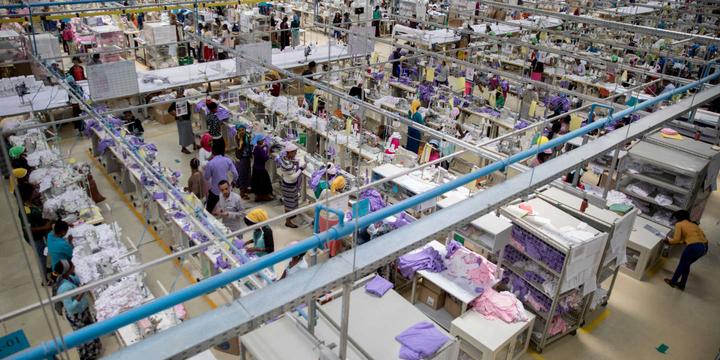CO2, water, microplastic: fashion is one of the most polluting industries in the world
Always more clothes and less and less expensive. The success of ready-to-wear has revolutionized the way we buy clothes, but has made fashion one of the most polluting industries on the planet. For the first time, on the sidelines of the G7, thirty-two textile companies, from the Adidas and Nike groups to Chanel and Prada, via H&M and Gap, have decided to commit to reducing the carbon footprint of the sector. clothing. On Friday August 23, these fashion giants signed a "Fashion Pact" aiming to achieve zero net carbon dioxide (CO2) emissions by 2050 and move to 100% renewable energy across the entire supply chain by 2030.
More than 12 kg of clothing per year for a European
According to According to the European Environment Agency (EEA), the quantity of clothing purchased in the European Union (EU) increased by 40% between 1996 and 2012. In 2015, Europeans acquired 6.4 million tonnes of new clothes and shoes, according to a study by the European Parliament. Globally, the trend is the same: 100 billion pieces of clothing were consumed worldwide in 2014, according to Greenpeace. This consumption frenzy has been on the rise since the 2000s.
Sales of clothing and footwear continue to climb
Source: Market research provider, Euromonitor international
This consumption hides strong disparities. While a North American buys an average of 16 kg of clothing per year, the figure only reaches 12.6 kg in the European Union and drops to just 2 kg in Middle Eastern countries, according to Greenpeace. However, demand for clothing is on the rise in Asia and South America, according to the Ellen MacArthur Environmental Foundation. The French are in the low average in Europe, with 9 kg of clothing purchased per person per year, following a downward curve since the 1960s. According to the National Institute of Statistics and Economic Studies (Insee), the budget households has been increasingly constrained by pre-committed expenses that are difficult to negotiate in the short term (rent, insurance and telephone contracts). Many French households have therefore reduced their clothing purchases to compensate. The second-hand market has also established itself well in France after the economic crisis of 2008, contributing to the decrease in purchases in stores.
The French rank among the smallest buyers in the European Union
Source: ECAP
More accessible and faster fashion
First reason for this growing craze for fashion: the rise of the middle classes in developing countries and the fall in clothing prices. With the development of ready-to-wear from the 1950s, then the numerous relocations of textile production to countries with lower production costs, 5-euro T-shirts arrived on the shelves, allowing a growing middle class to consume more.
In twenty years, the price of clothing has increased less than other consumer goods
Source: Euromonitor; McKinsey analysis

In the early 2000s, fast fashion arrived. Some brands are moving from the traditional spring-summer and autumn-winter collections to around ten collections a year. Zara even renews its shelves twenty-four times each year. As a result, the lifespan of a garment has been halved over the past fifteen years, according to a study by the consulting firm McKinsey. And nearly a third of Europeans' wardrobes haven't come out of the closet for at least a year, according to the EEA.
A lot of clothes therefore end up in the trash. With recycling methods still inefficient, only 1% of the materials used in making clothes are used to make new ones, according to the Ellen MacArthur Foundation. In total, just under two-thirds of all global production ends up in landfills or incinerators, McKinsey estimates.
7,500 liters of water to make jeans
The fashion industry is a major consumer of raw materials, especially cotton, which accounts for a quarter of global textile production. However, its cultivation is not without consequences for the environment. A United Nations report estimates that it takes 7,500 liters of water to make one pair of jeans, equivalent to the water a human drinks for seven years.
Necessary for all stages of garment manufacturing, water is also essential for applying dyes and chemicals. Ninety-three billion cubic meters of water are used by the textile industry each year, according to the Ellen MacArthur Foundation.
Another raw material, of which we think less, is essential to the fashion industry: oil, which is used in particular to make polyester. This synthetic fiber has become, from the beginning of the 2000s, the material most used in ready-to-wear, because it is inexpensive and more resistant than cotton. However, this fossil resource is not renewable.
Explosion of polyester in the textile industry
Source: Tecnon OrbiChem
High greenhouse gas emissions
The fashion industry produces high greenhouse gas emissions. They are linked to the production of raw materials, through the breeding of cows, to produce leather, or sheep, to produce wool. Added to this is the question of the transport of textiles and finished products. It is mainly done by plane, the fastest means of transport, but a major producer of CO2, and over long distances, since the vast majority of clothes purchased in the West are imported from South Asia. -East. However, the transport of raw materials and finished products only covers 2% of the greenhouse gas emissions produced by the fashion industry, according to an estimate by the Ellen MacArthur Foundation. The carbon footprint of fashion is particularly high because of the production of textiles. The manufacture of cotton, artificial and natural synthetic materials alone produces 1.2 billion tons of greenhouse gases, again according to the environmental organization.
Laundry and microplastics
The biggest environmental impact of fashion is not related to raw materials, production or transport, but to the washing of clothes. Both because of the water and energy used, but also because of the water and soil pollution it causes.
Indeed, textile fibers contain chemicals, mainly detergents from laundry or perfumes, and microplastics, contained in polyester or acrylic polymers. These particles are released into the oceans during washing and take decades to degrade. More than a third (35%) of microplastics released into the oceans come from washing textiles, according to the environmental organization the International Union for Conservation of Nature (IUCN).
Juliette Desmonceaux
Contribute








